How to check if your Deep Learning model is underfitting or overfitting?
December 1, 2020 by Chris
Training a Deep Learning model means that you have to balance between finding a model that works, i.e. that has predictive power, and one that works in many cases, i.e. a model that can generalize well.
This is a difficult task, because the balance is precise, and can sometimes be difficult to find.
In this article, we will be precisely looking at this balance. We will first take a look at what training a Deep Learning model involves by taking a high-level perspective. We then move forward and check what it means to overfit and underfit those models, and that the balance in between these two is crucial for Machine Learning success. We'll then show you how you can check whether your model is underfitting, and also whether it is overfitting.
This way, you can ensure that you have a model that works in many cases, rather than just a few training ones.
Let's take a look! 😎
Update 13/Jan/2021: Ensured that the article is up-to-date. Added a quick answer to the top of the article, changed header information and added links to other articles.
Quick Answer: How to see if your model is underfitting or overfitting?
Use these steps to determine if your machine learning model, deep learning model or neural network is currently underfit or overfit.
- Ensure that you are using validation loss next to training loss in the training phase.
- When your validation loss is decreasing, the model is still underfit.
- When your validation loss is increasing, the model is overfit.
- When your validation loss is equal, the model is either perfectly fit or in a local minimum.
If you want to understand the whys in more detail, make sure to keep reading the rest of this tutorial! 🚀
Training a Deep Learning model: a high-level process
If we want to understand the concepts of underfitting and overfitting, we must place it into the context of training a Deep Learning model. That's why I think that we should take a look at how such a model is trained first.
At a high level, training such a model involves three main phases. These phases are cyclical, meaning that training a Deep Learning model is an iterative process. These are the three main components of a training step:
- Feeding samples to the Deep Learning model. During a training step, samples from your training dataset are fed forward through the model. We call this the forwards pass. For each sample that is fed forward, a prediction is generated.
- Comparing the predictions and the ground truth. The predictions that are generated by the Deep Learning model are compared with the actual target values for the samples, which are called the ground truth. These comparisons are then jointly combined into a so-called loss score by a loss function. This score indicates how bad your model performs at this time.
- Improving the Deep Learning model. Using a technique called backpropagation, we can then (automatically) compute the contribution of the different parts of the Neural Network to the loss score. If we know this contribution, we know into what direction to move in order to improve - the direction here called a gradient. Using those gradients and the model, we can use optimizers for actually optimizing the model.
With these three steps, you'll eventually get a model that is optimized for the dataset that it is trained with.
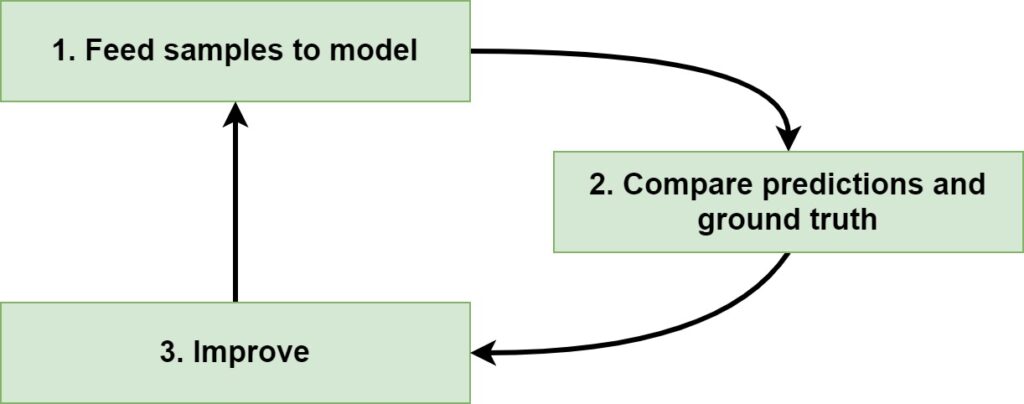
Overfitting and underfitting Machine Learning models
Suppose that we have the following observations, where a relationship \(\text{X} \rightarrow \text{y}\) exists:
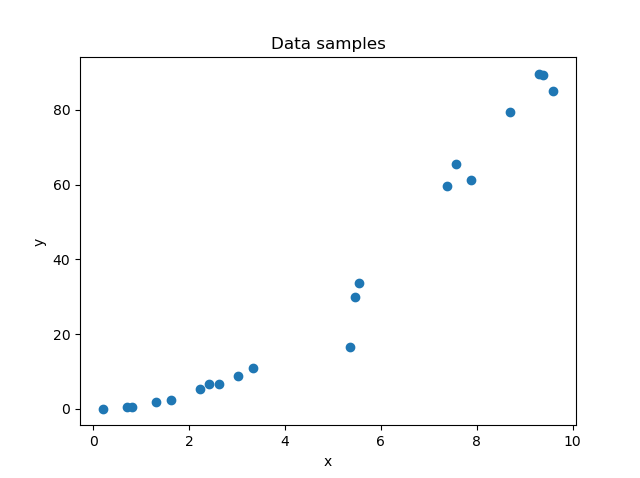
We can generate a predictive model that captures this relationship and allows us to predict any value for \(\text{y}\) within the domain of \(\text{x}\) displayed in the plot:
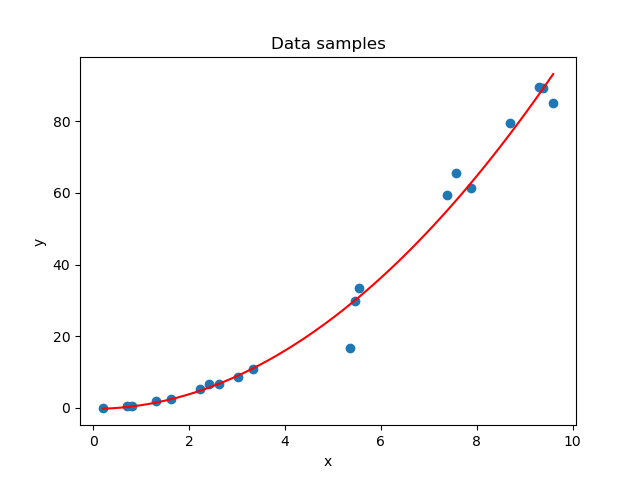
Fitting a model is another term that is used for this process of building and training a Deep Learning model.
Although it sounds simple, it can actually be really difficult to do just that. If we end up with a model that has the fit as displayed above, we have struck a precise balance between a model that is underfit and between one that is highly overfit.
Time to take a look at the two in more detail.
What is underfitting a Machine Learning Model?
Sometimes, your Deep Learning model is not able to capture the relationship between your independent variables and your dependent variable(s). In other words, we have then underfit our model.
Underfitting occurs when a statistical model cannot adequately capture the underlying structure of the data. An under-fitted model is a model where some parameters or terms that would appear in a correctly specified model are missing.
Wikipedia (2003)
In the case of our Deep Learning model, the relationship between \(\text{X} \rightarrow \text{y}\) cannot be captured properly if the model is underfit, and a plot of the fit would look like this:
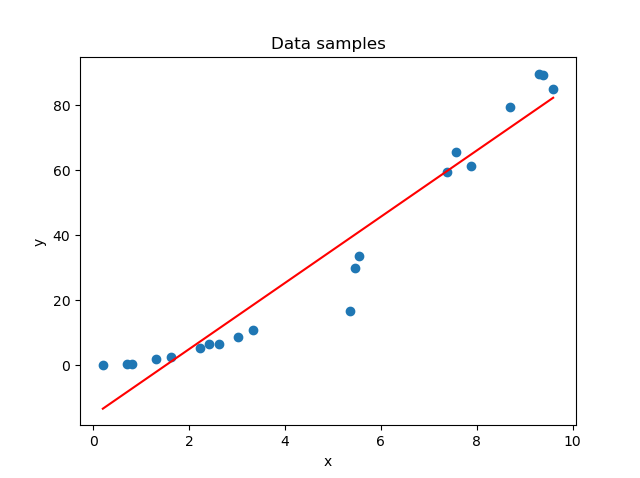
Underfitting can have many causes and by consequence fixes:
- You haven't trained your model for long enough, and adding extra training time might help you generate a better fit.
- You haven't trained with the appropriate architecture/model type. For example, if your dataset is nonlinear and you used linear activation functions, your Deep Learning model will not be able to properly capture the patterns from the dataset.
In other words, underfitting occurs when the model shows high bias and low variance.
What is overfitting a Machine Learning model?
Above, we looked at one side of the balance between a good fit and a poor one. Let's now take a look at the other one, i.e., what happens when your model is overfit.
The essence of overfitting is to have unknowingly extracted some of the residual variation (i.e. the noise) as if that variation represented underlying model structure.
Wikipedia (2003)
In each dataset, noise is present, besides the patterns that actually describe the relationship. If we train our model in such a way that it captures these patterns in great detail, we are training a model that is overfit. In other words, it will work very well for the data that it is trained on, but does it also work with data that comes from the real world? After all, the noise may not be present there?
If we visualize what overfitting means for our setting, we get the following visualization:

Here, we can clearly see that our models capture much of the noise: what should be a smooth, quadratic rise (the function we actually visualized is the function \(x^2\) at the domain \(x \in [0, 10]\)) is now a noisy one. We therefore have introduced noise into our model which is not present in our 'real world' (i.e., in \(x^2\))!
In the real world, the odds are relatively low that you will produce a model that is underfit. Overfitting is the problem: today's real-world datasets are often highly complex and have many variables. Capturing noise is really easy these days!
Checking for underfitting/overfitting
Visualizing loss
When you are training a Deep Learning model, for example with Keras, you specify a loss function. This function, which produces a value that tells you something about how bad your model performs, can be constructed based on training data or validation data. We can specify such a loss function in the model.compile step.
During training, we always need to rely on validation data when estimating the performance of our model (relying on the training data for estimating model performance is like checking your own homework). That's why we specify a validation split in model.fit. Together, this can look as follows:
# Compile the model
model.compile(loss=categorical_crossentropy,
optimizer=Adam(),
metrics=['accuracy'])
# Fit data to model
model.fit(X_train, y_train,
batch_size=batch_size,
epochs=no_epochs,
verbose=verbosity,
validation_split=validation_split_size)
When we start the training process, we can now both see loss (loss based on training data) and val_loss (loss based on validation data) besides our epochs:
Epoch 1/25
5832/5832 [==============================] - 1s 203us/sample - loss: 2.2721 - accuracy: 0.1811 - val_loss: 2.2729 - val_accuracy: 0.1590
Epoch 2/25
5832/5832 [==============================] - 0s 27us/sample - loss: 2.2347 - accuracy: 0.2172 - val_loss: 2.2235 - val_accuracy: 0.2879
Epoch 3/25
5832/5832 [==============================] - 0s 23us/sample - loss: 2.1743 - accuracy: 0.2723 - val_loss: 2.1465 - val_accuracy: 0.2934
Epoch 4/25
5832/5832 [==============================] - 0s 25us/sample - loss: 2.0708 - accuracy: 0.3014 - val_loss: 2.0082 - val_accuracy: 0.3132
Epoch 5/25
5832/5832 [==============================] - 0s 25us/sample - loss: 1.9090 - accuracy: 0.3527 - val_loss: 1.8271 - val_accuracy: 0.3722
Epoch 6/25
5832/5832 [==============================] - 0s 23us/sample - loss: 1.7152 - accuracy: 0.4504 - val_loss: 1.6274 - val_accuracy: 0.5435
Epoch 7/25
5832/5832 [==============================] - 0s 24us/sample - loss: 1.5153 - accuracy: 0.6020 - val_loss: 1.4348 - val_accuracy: 0.6580
Epoch 8/25
5832/5832 [==============================] - 0s 23us/sample - loss: 1.3304 - accuracy: 0.6965 - val_loss: 1.2606 - val_accuracy: 0.6929
Epoch 9/25
5832/5832 [==============================] - 0s 25us/sample - loss: 1.1723 - accuracy: 0.7443 - val_loss: 1.1096 - val_accuracy: 0.7676
We can now manually plot this loss or use TensorBoard if we want to visualize loss in realtime.
A plot of your validation loss, after some epochs, will look somewhat like this:
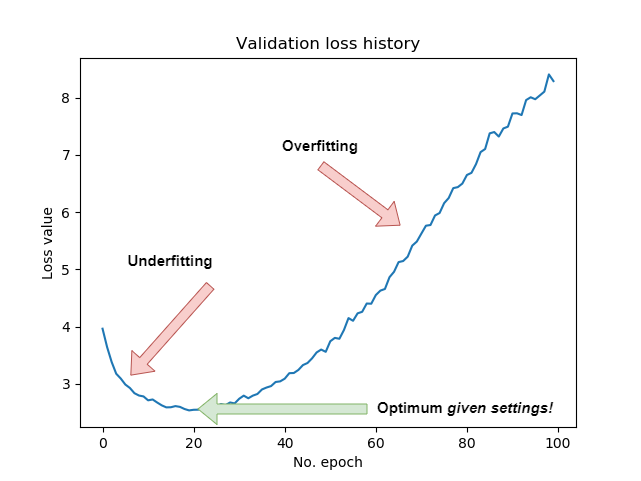
Checking for underfitting
Using validation loss, we can find whether our model is underfitting. Recall that when it does, the model can still gain predictive power without being too trained on the training dataset itself.
The general rule for calling a model underfit is as follows:
- A model can be considered underfit if your validation loss is still decreasing.
For this reason: if your validation loss decreases, don't stop the training process.
Checking for overfitting
Recall, however, that overfitting is the bigger problem these days. Whereas it is relatively easy to fight underfitting (just keep the training process running), avoiding overfitting is more difficult.
But how can we know whether our model is overfitting in the first place?
Here, too, we have a general rule:
- A model can be considered overfit if your validation loss has been increasing (for some time).
Think about what this means: if validation loss starts to increase, the model - when trained - becomes progressively worse during the check.
In other words, it has now started learning patterns that are not present within the dataset.
Especially around the optimum loss can oscillate a bit, so don't stop training immediately; perhaps you are at a local optimum, and loss will decrease further. However, if it keeps increasing, you can stop the training process.
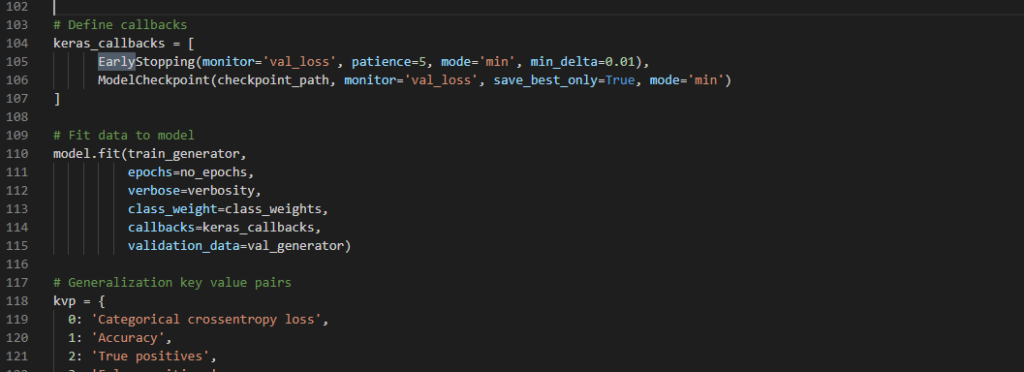
Find the optimum!
Training a Deep Learning model involves finding the balance between a model that is underfit and one that is overfit, yielding a model that has a good fit. As you saw above, we can find this optimum where the change in loss for some iteration is ~0 for a series of epochs. At precisely that time, we can stop the training process.
It is possible to instruct TensorFlow to train your Keras model while automatically monitoring for this balance. Using both the EarlyStopping and ModelCheckpoint callbacks, you can ensure that your model stops training when this optimum is reached. Isn't that easy!
Summary
In this article, we looked at the concepts of overfitting and underfitting for your Deep Learning model. Because, well, what do they mean - and how can we check if our model is underfit or if it is overfit? First of all, we saw what happens during a Deep Learning training process from a high-level perspective. We saw that samples are fed forward through the model, that predictions are generated and compared with the actual targets, and that the model is subsequently improved (partially) based on these computations.
We also saw that when our model is underfit, it is not yet capable of capturing the relevant patterns within the dataset. In other words, if our dataset represents a quadratic function, the function that would be fit would likely be in the shape of a line. If our model is overfit, however, any noise in the dataset disturbs the fit significantly - meaning that it is too focused on the training data at hand.
Validation loss can be used for checking whether your model is underfitting or whether it is overfitting. If you plot validation loss, by configuring it in model.compile and model.fit in Keras and subsequently generating a plot in TensorBoard, you can estimate how your model is doing. When validation loss keeps decreasing, your model is still underfit. When it continues to rise, overfitting is occurring. You therefore want a model that is trained to be at the precise balance between the two, where the change in loss is zero.
I hope that you have learned something from this article. If you did, please feel free to leave a comment in the comments section below 💬 Please feel free to do the same if you have any questions, comments or other remarks. Regardless of that, thank you for reading MachineCurve today and happy engineering! 😎
References
Wikipedia. (2003, January 23). Overfitting. Wikipedia, the free encyclopedia. Retrieved November 30, 2020, from https://en.wikipedia.org/wiki/Overfitting

Hi, I'm Chris!
I know a thing or two about AI and machine learning. Welcome to MachineCurve.com, where machine learning is explained in gentle terms.
Getting started
Foundation models
Learn how large language models and other foundation models are working and how you can train open source ones yourself.
Keras
Keras is a high-level API for TensorFlow. It is one of the most popular deep learning frameworks.
Machine learning theory
Read about the fundamentals of machine learning, deep learning and artificial intelligence.
Most recent articles
January 2, 2024
What is Retrieval-Augmented Generation?
December 27, 2023
In-Context Learning: what it is and how it works
December 22, 2023
CLIP: how it works, how it's trained and how to use it
Article tags
Most popular articles
February 18, 2020
How to use K-fold Cross Validation with TensorFlow 2 and Keras?
December 28, 2020
Introduction to Transformers in Machine Learning
December 27, 2021
StyleGAN, a step-by-step introduction
July 17, 2019
This Person Does Not Exist - how does it work?
October 26, 2020
Your First Machine Learning Project with TensorFlow 2.0 and Keras
Connect on social media
Connect with me on LinkedIn
To get in touch with me, please connect with me on LinkedIn. Make sure to write me a message saying hi!
Side info
The content on this website is written for educational purposes. In writing the articles, I have attempted to be as correct and precise as possible. Should you find any errors, please let me know by creating an issue or pull request in this GitHub repository.
All text on this website written by me is copyrighted and may not be used without prior permission. Creating citations using content from this website is allowed if a reference is added, including an URL reference to the referenced article.
If you have any questions or remarks, feel free to get in touch.
TensorFlow, the TensorFlow logo and any related marks are trademarks of Google Inc.
PyTorch, the PyTorch logo and any related marks are trademarks of The Linux Foundation.
Montserrat and Source Sans are fonts licensed under the SIL Open Font License version 1.1.
Mathjax is licensed under the Apache License, Version 2.0.